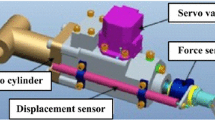Abstract
In this paper, the motion of a finger-follower type cam valve system with a hydraulic tappet was analytically and experimentally studied. First, the exact contact point between cam and follower for each corresponding cam angle was searched by kinematic analysis. Then a 6 degree of freedom lumped spring-damper-mass model was constructed to simulate the valve motion analytically. When constructing the model, most of the parameters were experimentally determined. But several values which are difficult to derive experimentally such as damping coefficients were determined with engineering intuition. In order to show the effectiveness of the analytical model, the predicted cam-valve motion was directly compared with the measured valve and tappet motions.
Similar content being viewed by others
Abbreviations
- A e :
-
Equivalent cross-sectional area of oil chamber in tappet, m2
- C l , Cs2,C s3 :
-
Equivalent damping coefficients of valve spring, N/m
- C se :
-
Damping coefficient of valve seat, N-s/m
- C tf ,C vf ,C fc :
-
Equivalent damping coefficients of contact point, N-s/m
- C tp :
-
Equivalent damping coefficient of tappet, N-s/m
- f o :
-
Fundamental natural frequency of valve spring, Hz
- F o :
-
Initial compression force of valve spring,N
- F tf ,F vf ,F fc :
-
Contact forces at each contact point,N
- F tfo ,F vfo ,F fco :
-
Initial contact forces at each contact point,N
- h :
-
Clearance between cylinder and plunger, mm
- H e :
-
Length of compressed oil chamber, mm
- I F :
-
Follower moment of inertia, kg-m2
- K o :
-
Valve spring stiffness, N/m
- K e :
-
Equivalent stiffness of tappet oil chamber, N/m
- K s1 ,K s2 ,K s3 :
-
Equivalent stiffness coefficients of valve spring, N/m
- K s :
-
Stiffness of tappet soft spring, N/m
- K tf ,K vf ,K fc :
-
Equivalent stiffness coefficients of contact point, N/m
- L :
-
Plunger length, mm
- L tf :
-
Lever arm of forceF tf , mm
- L vf :
-
Lever arm of forceF vf , mm
- mc :
-
Mass of oil inside tappet oil chamber, kg
- M f :
-
Follower mass, kg
- M t :
-
Equivalent tappet mass, kg
- M v :
-
Equivalent valve mass, kg
- m1, m2 :
-
Equivalent valve spring masses, kg
- R p :
-
Radius of tappet plunger, mm
- R c :
-
Radius of cam base circle, mm
- R ab :
-
Distance from cam pivot to follower pivot, mm
- R 1 :
-
length of oscillating roller follower, mm
- R f :
-
Radius of roller in roller follower model, mm
- Y f :
-
Follower displacement, mm
- Y t :
-
Tappet displacement, μm
- Y c :
-
Cam lift, mm
- Y v :
-
Valve displacement, mm
- Y s1 ,Y s2 :
-
Displacements of equivalent valve spring masses, mm
- θ f :
-
Angular rotation of follower, radian
- μ:
-
Oil viscosity coefficient, Pa-s
- E :
-
Bulk modulus, N/m2
- ϱ:
-
Angular rotation of cam, radian
References
Chan, C. and Pisano, A., 1987, “Dynamic Model of Fluctuating Rocker-Arm Ratio Cam System”, ASME J. Mech. Trans. Automation in Design. Vol. 109, pp. 356–365.
Jeon, H.S., Park, K.J. and Park, Y.S., 1989, “An Optimal Cam Profile Design Considerng Dynamic Characteristics of Cam-Valve System”, Experimental Mechanics, pp. 357–363.
Kreuter, P. and Maas, G., 1987, “Influence of Hydraulic Valve Lash Adjusters on the Dynamic Behavior of Valve Trains”, SAE Technical paper No. 870086.
Pisano, A.P. and Freudenstein, F., 1982, “An Experimental and Analytical Investigation of Dynamic Response of a High-speed Cam-Follower System. Part 1 and Part2”, ASME J. Mech. Trans. Automation in Design, Vol. 105, pp. 692–704.
Roark, R. and Young, W., 1976, “Formulas for Stress and Strain”, McGraw-Hill.
Sakai, H. and Kosaki, H., 1976, “Analysis of Valve Motion in Overhead Valve Linkages-Roles of Valve Spring Surge in Valve Motion”, Journal of the Faculty of Engineering, The University of Tokyo(B), Vol. 33, No. 4 pp. 441–446.
Akiba, K., Shimizu, A. and Sakai, H., “A Comprehensive Simulation of High Speed Driven Valve Trains”, SAE Technical Paper No. 810865.
Shoup, T., 1979. “A Practical Guide to Computer Methods for Engineers”, Prentice-Hall.
Author information
Authors and Affiliations
Rights and permissions
About this article
Cite this article
Kim, WJ., Jeon, HS. & Park, YS. Analytical and experimental motion analysis of finger follower type cam-valve system with a hydraulic tappet. KSME Journal 4, 40–47 (1990). https://doi.org/10.1007/BF02953389
Received:
Issue Date:
DOI: https://doi.org/10.1007/BF02953389



